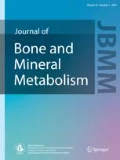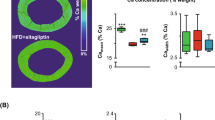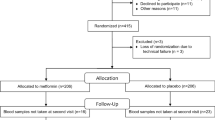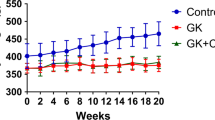Abstract
To explore the skeletal effects and the potential underlying mechanisms of treatment with two thiazolidinediones (rosiglitazone and pioglitazone) or metformin in insulin-resistant mice, 24 female, 12-week-old C57BL6J ob/ob mice were evaluated according to the following treatment groups for 6 weeks: placebo group, pioglitazone group (Pio), rosiglitazone group (Rosi), and metformin group (Met). Bone mineral density (BMD), bone microarchitecture, bone histomorphometry, and expression of three phenotype-specific gene markers, including bone morphogenetic protein 2 (Bmp2), runt-related transcription factor 2 (Runx2), and fatty acid-binding protein 4 (Fabp4), were compared across the four groups. At the femur, the Met group had the highest BMD (0.084 ± 0.001 g/cm2) and trabecular bone volume/total volume (0.644 ± 0.018 %) and the lowest trabecular spacing (Tb.Sp.) (0.143 ± 0.008 μm), whereas the Rosi group had lower BMD (0.076 ± 0.003 g/cm2) and a relatively higher degree of Tb.Sp. (0.173 ± 0.024 μm). A histomorphometric analysis revealed that in the Rosi group the number of adipocytes was fourfold higher than in the placebo group and fivefold higher than in the Met group, whereas the highest osteoid width and mineral apposition rate were found in the Met group (49.88 ± 48.53 μm and 4.46 ± 1.72 μm/day). Furthermore, the Rosi group displayed the highest level of Fabp4 gene expression, which was accompanied by normal expression levels of Bmp2 and Runx2. Seemingly, metformin is a bone-friendly antidiabetic drug. Rosiglitazone had adverse effects on the skeleton at the trabecular bone even in insulin-resistant mice, whereas no evidence of adverse effects was found for pioglitazone.

Similar content being viewed by others
References
Yang W, Lu J, Weng J, Jia W, Ji L, Xiao J, Shan Z, Liu J, Tian H, Ji Q, Zhu D, Ge J, Lin L, Chen L, Guo X, Zhao Z, Li Q, Zhou Z, Shan G, He J (2010) Prevalence of diabetes among men and women in China. N Engl J Med 362:1090–1101
Vestergaard P (2007) Discrepancies in bone mineral density and fracture risk in patients with type 1 and type 2 diabetes: a meta-analysis. Osteoporos Int 18:427–444
Janghorbani M, Van Dam RM, Willett WC, Hu FB (2007) Systematic review of type 1 and type 2 diabetes mellitus and risk of fracture. Am J Epidemiol 166:495–505
Kahn SE, Zinman B, Lachin JM, Haffner SM, Herman WH, Holman RR, Kravitz BG, Yu D, Heise MA, Aftring RP, Viberti G (2008) Rosiglitazone-associated fractures in type 2 diabetes: an analysis from A Diabetes Outcome Progression Trial (ADOPT). Diabetes Care 31:845–851
Aubert RE, Herrera V, Chen W, Haffner SM, Pendergrass M (2010) Rosiglitazone and pioglitazone increase fracture risk in women and men with type 2 diabetes. Diabetes Obes Metab 12:716–721
Douglas IJ, Evans SJ, Pocock S, Smeeth L (2009) The risk of fractures associated with thiazolidinediones: a self-controlled case-series study. PLoS Med 6:e1000154
Berberoglu Z, Yazici AC, Demirag NG (2010) Effects of rosiglitazone on bone mineral density and remodelling parameters in postmenopausal diabetic women: a 2-year follow-up study. Clin Endocrinol (Oxf) 73:305–312
Loke YK, Singh S, Furberg CD (2009) Long-term use of thiazolidinediones and fractures in type 2 diabetes: a meta-analysis. CMAJ 180:32–39
Jones SG, Momin SR, Good MW, Shea TK, Patric K (2009) Distal upper and lower limb fractures associated with thiazolidinedione use. Am J Manag Care 15:491–496
Rzonca SO, Suva LJ, Gaddy D, Montague DC, Lecka-Czernik B (2004) Bone is a target for the antidiabetic compound rosiglitazone. Endocrinology 145:401–406
Viccica G, Francucci CM, Marcocci C (2010) The role of PPARgamma for the osteoblastic differentiation. J Endocrinol Invest 33:9–12
Lazarenko OP, Rzonca SO, Hogue WR, Swain FL, Suva LJ, Lecka-Czernik B (2007) Rosiglitazone induces decreases in bone mass and strength that are reminiscent of aged bone. Endocrinology 148:2669–2680
Adami S (2009) Bone health in diabetes: considerations for clinical management. Curr Med Res Opin 25:1057–1072
Kanazawa I, Yamaguchi T, Yano S, Yamauchi M, Sugimoto T (2008) Metformin enhances the differentiation and mineralization of osteoblastic MC3T3-E1 cells via AMP kinase activation as well as eNOS and BMP-2 expression. Biochem Biophys Res Commun 375:414–419
Srinivasan K, Ramarao P (2007) Animal models in type 2 diabetes research: an overview. Indian J Med Res 125:451–472
Bloebaum RD, Willie BM, Mitchell BS, Hofmann AA (2007) Relationship between bone ingrowth, mineral apposition rate, and osteoblast activity. J Biomed Mater Res A 81:505–514
Ali AA, Weinstein RS, Stewart SA, Parfitt AM, Manolagas SC, Jilka RL (2005) Rosiglitazone causes bone loss in mice by suppressing osteoblast differentiation and bone formation. Endocrinology 146:1226–1235
Ma L, Ji JL, Ji H, Yu X, Ding LJ, Liu K, Li YQ (2010) Telmisartan alleviates rosiglitazone-induced bone loss in ovariectomized spontaneous hypertensive rats. Bone (NY) 47:5–11
Parfitt AM, Drezner MK, Glorieux FH, Kanis JA, Malluche H, Meunier PJ, Ott SM, Recker RR (1987) Bone histomorphometry: standardization of nomenclature, symbols, and units. Report of the ASBMR Histomorphometry Nomenclature Committee. J Bone Miner Res 2:595–610
Bustin SA (2000) Absolute quantification of mRNA using real-time reverse transcription polymerase chain reaction assays. J Mol Endocrinol 25:169–193
Toulis KA, Goulis DG, Anastasilakis AD (2009) Thiazolidinedione use and the risk of fractures. CMAJ 180:841–842 (author reply 842–843)
Dormandy J, Bhattacharya M, van Troostenburg de Bruyn AR (2009) Safety and tolerability of pioglitazone in high-risk patients with type 2 diabetes: an overview of data from PROactive. Drug Saf 32:187–202
Glintborg D, Andersen M, Hagen C, Heickendorff L, Hermann AP (2008) Association of pioglitazone treatment with decreased bone mineral density in obese premenopausal patients with polycystic ovary syndrome: a randomized, placebo-controlled trial. J Clin Endocrinol Metab 93:1696–1701
Mai Q, Zhang Z, Xu S, Lu M, Zhou R, Zhao L, Jia C, Wen Z, Jin D, Bai X (2011) Metformin stimulates osteoprotegerin and reduces RANKL expression in osteoblasts and ovariectomized rats. J Cell Biochem 112:2902–2909
Jang WG, Kim EJ, Bae IH, Lee KN, Kim YD, Kim DK, Kim SH, Lee CH, Franceschi RT, Choi HS, Koh JT (2011) Metformin induces osteoblast differentiation via orphan nuclear receptor SHP-mediated transactivation of Runx2. Bone (NY) 48:885–893
Zhen D, Chen Y, Tang X (2010) Metformin reverses the deleterious effects of high glucose on osteoblast function. J Diabetes Complicat 24:334–344
Cabre A, Lazaro I, Girona J, Manzanares JM, Marimon F, Plana N, Heras M, Masana L (2007) Fatty acid binding protein 4 is increased in metabolic syndrome and with thiazolidinedione treatment in diabetic patients. Atherosclerosis 195:e150–e158
Sottile V, Seuwen K (2000) Bone morphogenetic protein-2 stimulates adipogenic differentiation of mesenchymal precursor cells in synergy with BRL 49653 (rosiglitazone). FEBS Lett 475:201–204
Chen D, Ji X, Harris MA, Feng JQ, Karsenty G, Celeste AJ, Rosen V, Mundy GR, Harris SE (1998) Differential roles for bone morphogenetic protein (BMP) receptor type IB and IA in differentiation and specification of mesenchymal precursor cells to osteoblast and adipocyte lineages. J Cell Biol 142:295–305
Zhang M, Zhou SH, Zhao S, Li XP, Liu LP, Shen XQ (2008) Pioglitazone can downregulate bone morphogenetic protein-2 expression induced by high glucose in human umbilical vein endothelial cells. Pharmacology 81:312–316
Acknowledgments
We are grateful to Dr. Guo-Ying Zhu, Dr. Xiao Chen, Dr. Hui-Min Yan, and Dr. Hui Xie for their excellent and generous assistance. The study was supported by the Shanghai Science & Technology Development Fund (Project No. 08411963100) and the Shanghai Natural Science Foundation 11ZR1427300 (Science and Technology commission of Shanghai municipality).
Conflict of interest
None.
Author information
Authors and Affiliations
Corresponding author
Additional information
C. Wang and H. Li contributed equally to this work.
About this article
Cite this article
Wang, C., Li, H., Chen, SG. et al. The skeletal effects of thiazolidinedione and metformin on insulin-resistant mice. J Bone Miner Metab 30, 630–637 (2012). https://doi.org/10.1007/s00774-012-0374-0
Received:
Accepted:
Published:
Issue Date:
DOI: https://doi.org/10.1007/s00774-012-0374-0




